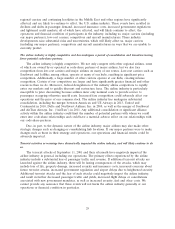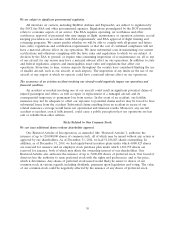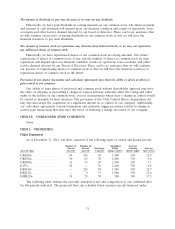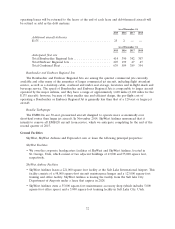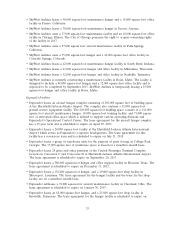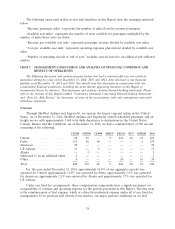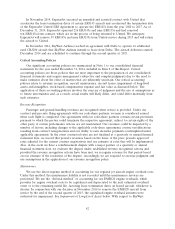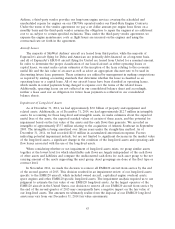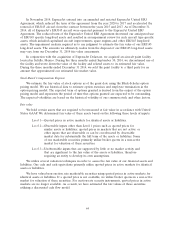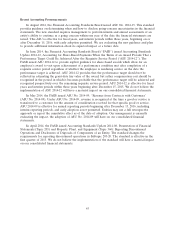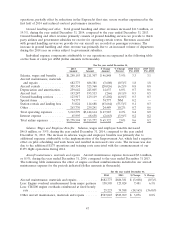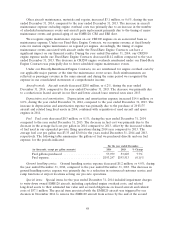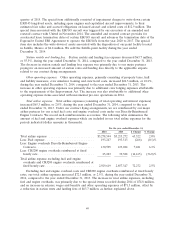SkyWest Airlines 2014 Annual Report Download - page 44
Download and view the complete annual report
Please find page 44 of the 2014 SkyWest Airlines annual report below. You can navigate through the pages in the report by either clicking on the pages listed below, or by using the keyword search tool below to find specific information within the annual report.expense incurred under each respective fixed-fee contract, and we record such reimbursement as
passenger revenue. Thus, the price volatility of fuel and the volume of fuel expensed under our
fixed-fee arrangements during a particular period will impact our fuel expense and our passenger
revenue during the period equally, with no impact on our operating income. Over the past few years,
some of our major airline partners have purchased an increased volume of fuel directly from vendors
on flights we operated under our fixed-fee contracts, which has decreased both revenue and operating
expenses compared to previous periods presented in this Report.
The second item is the reimbursement of landing fees and station rents, which is a directly-
reimbursed expense under all of our fixed-fee arrangements. Our major partners reimburse us for
landing fees and station rent expense incurred under each respective fixed-fee contract, and we record
such reimbursement as passenger revenue. Over the past few years, some of our major airline partners
have paid an increased volume of landing fees and station rents directly to our vendors on flights we
operated under our flying contracts, which has also decreased both revenue and operating expenses
compared to previous periods presented in this Report.
The third item is the compensation we receive for engine maintenance under our fixed-fee
arrangements. Under our United CRJ and E175 contracts, American, US Airways and Alaska fixed-fee
contracts, a portion of our compensation is based upon fixed hourly rates the aircraft is in operation,
which is intended to cover various operating costs, including engine maintenance costs (‘‘Fixed-Rate
Engine Contracts’’). Under the compensation structure for our Delta Connection and United ERJ145
flying contracts, our major partner reimburses us for engine maintenance expense when the expense is
incurred as a pass-through cost (‘‘Directly-Reimbursed Engine Contracts’’). We use the direct-expense
method of accounting for our CRJ200 regional jet aircraft engine overhaul costs and, accordingly, we
recognize engine maintenance expense on our CRJ200 engines on an as-incurred basis. Under the
direct-expense method, the maintenance liability is recorded when the maintenance services are
performed (‘‘CRJ200 Engine Overhaul Expense’’).
Because we use the direct-expense method of accounting for our CRJ200 engine expense, and
because we recognize revenue using the applicable fixed hourly rates under our Fixed-Rate Engine
Contracts, the number of engine maintenance events and related expense we incur each reporting
period under the Fixed-Rate Engine Contracts has a direct impact on the comparability of our
operating income for the presented reporting periods.
Because we recognize revenue at the same amount and in the same period when we incur engine
maintenance expense on engines operating under our Directly-Reimbursed Engine Contracts, the
number of engine events and related expense we incur each reporting period does not have a direct
impact on the comparability of our operating income for the presented reporting periods.
We have an agreement with a third-party vendor to provide long-term engine maintenance
covering scheduled and unscheduled repairs for engines on our CRJ700s operating under our
Fixed-Rate Engine Contracts (a ‘‘Power by the Hour Agreement’’). Under the terms of the Power by
the Hour Agreement, we are obligated to pay a set dollar amount per engine hour flown on a monthly
basis and the vendor assumes the obligation to repair the engines at no additional cost to us, subject to
certain specified exclusions. Thus, under the Power by the Hour Agreement, we expense the engine
maintenance costs as flight hours are incurred on the engines and using the contractual rate set forth in
the agreement. Because we record engine maintenance expense based on the fixed hourly rate pursuant
to the Power by the Hour Agreement on our CRJ700s operating under our Fixed-Rate Engine
Contracts, and because we recognize revenue using the applicable fixed hourly rates under our
Fixed-Rate Engine Contracts, the number of engine events and related expense we incur each reporting
period does not have a direct impact on the comparability of our operating income for the presented
39


